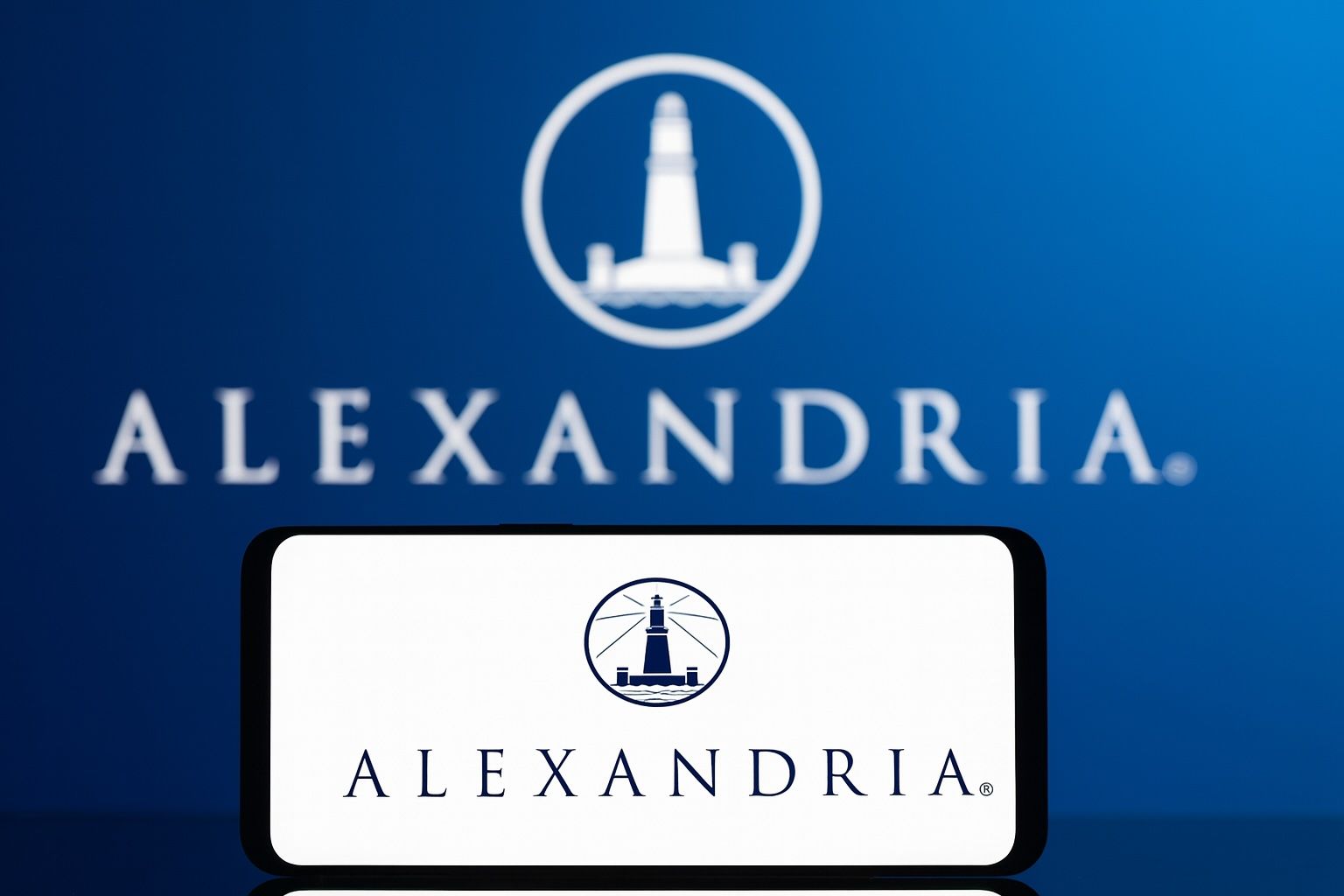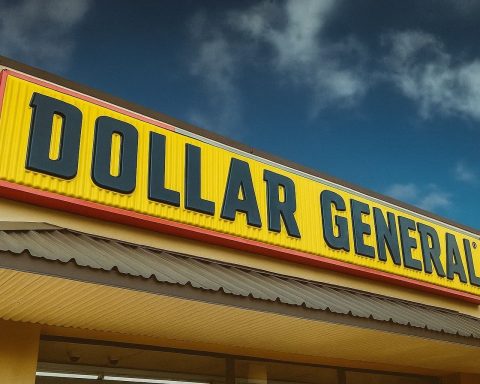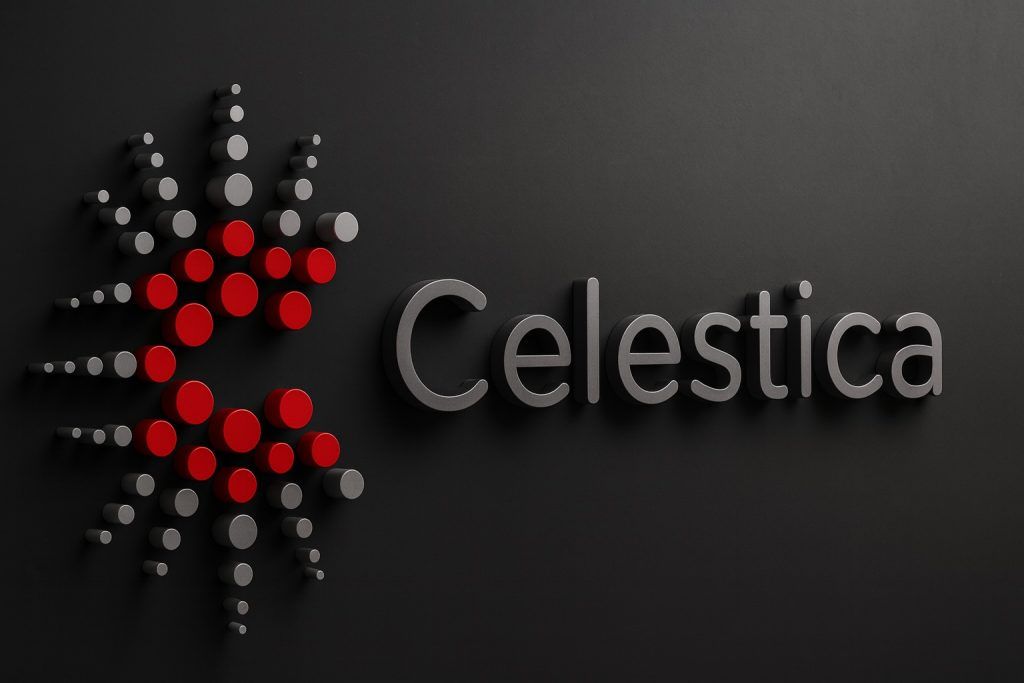- Stock Hits New Low: Alexandria Real Estate Equities’ shares plunged ~16% to around $65 on October 28, 2025, marking a fresh 52-week low of $67.18 intraday [1] [2]. The stock has fallen ~42% over the past year amid investor concerns, sending its dividend yield to roughly 7% [3]. Technical indicators show oversold conditions and potential undervaluation at these levels [4].
- Disappointing Q3 Results: The life-science-focused REIT reported Q3 2025 adjusted funds from operations (AFFO) of $2.22 per share, missing consensus by $0.09 [5]. Revenue of $751.9 million also slightly missed estimates [6]. Management cut its full-year 2025 AFFO guidance to $8.98–$9.04 (from a prior $9.16–$9.36) [7], citing softer demand and rising vacancies in its lab office portfolio. Operating occupancy has slipped to 90.6% as of Q3, down from 94.7% a year ago [8] [9].
- Analysts Split on Outlook: Wall Street is divided on ARE’s prospects. Recent downgrades include BNP Paribas Exane to Underperform (target $82) and Cantor Fitzgerald cutting its target to $79 (Neutral stance) [10]. Jefferies initiated coverage at Hold with an $80 target, noting Alexandria’s status as the largest life science landlord but highlighting sector headwinds [11]. On the bullish side, BMO Capital reaffirmed a Buy with a $100 target [12], and consensus 12-month targets average around $89 (~15% above the pre-drop price) [13] – though forecasts range widely from $42 to $130 [14].
- Sector Headwinds: Alexandria’s challenges reflect broader trends in biotech real estate. After a pandemic-fueled boom, 2025 has seen a sharp drop-off in lab space demand and a surge in oversupply, with global life science vacancy rates reaching ~23% [15]. In the U.S., key hubs like Boston and San Francisco are seeing record-high vacancies and downward pressure on rents [16] [17]. Alexandria warned that slower leasing and new lab supply are likely to further pressure occupancy into 2026 [18] [19]. Higher interest rates have also hit REIT valuations, as rising Treasury yields and financing costs make high-yield real estate stocks less attractive relative to bonds. The S&P 500 real estate sector has badly lagged the broader market; U.S. REIT stocks remain ~10% below their early 2022 peak even as the S&P 500 pushes record highs [20].
- Resilience and Recent Developments: Despite near-term headwinds, Alexandria points to its strong liquidity and portfolio strengths. The company holds $4.2 billion in liquidity (over 4× its debt maturities through 2027) [21], providing a buffer as it navigates the downturn. It has maintained 14 consecutive years of dividend increases [22], declaring a quarterly dividend of $1.32 per share for Q3 (up 2.7% year-over-year) [23]. Notably, the REIT executed the largest lease in its history this year – a 16-year, 466,598 RSF build-to-suit deal with a major pharmaceutical tenant in San Diego [24] [25] – underscoring ongoing demand for top-tier lab campuses. It also just opened “Lilly Gateway Labs” in San Diego in partnership with Eli Lilly, a new biotech incubator at its Alexandria Square campus [26], highlighting the firm’s role in high-profile life science initiatives.
Stock Nosedives on Earnings News
Pasadena, Calif., Oct. 28, 2025 – Alexandria Real Estate Equities (NYSE: ARE) saw its stock price collapse to a new 52-week low in Tuesday’s trading, as disappointing quarterly results and lowered guidance fueled a sharp sell-off. By mid-afternoon, shares were down roughly 16% on the day around the mid-$60s [27], recovering slightly from an early dip to ~$65.20. The steep drop came on unusually heavy volume as investors reacted to mounting signs of trouble for the office/lab space landlord. Tuesday’s decline extends a prolonged slump for Alexandria’s stock – which has now shed about 41.9% of its value in the past year [28] amid broader real estate market weakness.
Hitting an intraday low of $67.18 (a level not seen in years) [29], ARE’s latest slide reflects ongoing investor concerns about the life science real estate sector and the company’s earnings trajectory. The REIT’s market capitalization has dramatically eroded in 2025 as rising interest rates, higher vacancies, and waning investor appetite for REITs have all taken a toll. At the new low, Alexandria’s dividend yield swelled to roughly 7%, a sign of both the stock’s underperformance and the rich payouts it continues to offer [30].
Some market analysts note that the sell-off may be overdone. Investing.com data shows the stock appearing oversold by technical measures and potentially undervalued at current prices [31]. The company’s robust balance sheet – including a current ratio of 3.24 indicating solid short-term liquidity – and prime portfolio of life science campuses could support a turnaround [32]. “ARE’s fundamentals aren’t broken, but sentiment is,” said one strategist, pointing to the REIT’s long track record and asset quality. Still, catching this falling knife is risky: the new low “highlights ongoing investor concerns and reflects broader difficulties facing the real estate sector in the current economic climate” [33].
Q3 Earnings Miss, Lower Guidance Rattle Investors
Alexandria’s latest quarterly report, released late on Oct. 27, appeared to catalyze the stock’s dive. The REIT reported Q3 2025 adjusted FFO (AFFO) of $2.22 per share, which missed Wall Street’s expectation of ~$2.31 [34]. It also posted a net loss for the quarter (GAAP net loss of $1.38 per share) due largely to real estate impairments and non-cash charges. Revenue came in at $751.95 million, slightly below consensus (miss by ~$2.4 million) [35] – indicating slower growth as leasing decelerates.
More troubling to investors was management’s move to cut full-year guidance. Citing “existing market conditions and assumptions,” Alexandria lowered its 2025 AFFO outlook to $8.98–$9.04 per share (from a prior range of $9.16–$9.36) [36]. The midpoint implies full-year growth of only ~3% and reflects $0.25 of downside revision this quarter [37]. In a supplemental report, the company explained that slower-than-anticipated re-leasing of expiring space and prolonged vacancy lease-up times in its portfolio drove the reduced forecast [38]. Additionally, planned asset sales have been delayed, prompting Alexandria to trim its expected 2025 disposition volume by $450 million – which in turn raises projected interest expense and leverage [39] [40].
Operational metrics from Q3 underscored the headwinds. Occupancy has declined for four consecutive quarters, slipping to 90.6% as of Sept. 30, 2025 [41] [42]. That’s down from 94.7% a year prior, as the company has struggled to backfill vacated space amid a sector slowdown. Same-property net operating income fell ~6% year-over-year in Q3 [43], and management warned that Q4 could bring a further ~0.8% drop in occupancy (to the high-89% range) even after accounting for potential reclassification of some vacant properties as “held for sale” [44] [45]. Notably, a cluster of key tenant leases – about 1.2 million sq. ft. primarily in Boston, San Francisco, and San Diego – are set to expire around March 2026, and the company expects those spaces to go vacant, requiring 6–24 months to re-lease [46] [47]. This looming rollover adds further uncertainty to near-term cash flows.
On the earnings call, executives struck a sober tone. CEO Peter Moglia acknowledged the “slower demand across the life science sector and increased supply of lab space” that are weighing on Alexandria’s performance [48]. The company is responding by pausing certain development projects and will introduce a comprehensive 2026 outlook at its December 3 Investor Day [49]. In the meantime, Alexandria is pushing ahead with asset sales to raise cash: through late October, it closed $508 million in property dispositions and has about $1.0 billion more in negotiations [50]. Management expects to achieve cap rates in the 7.5%–8.5% range on 2025 dispositions [51] – a relatively high yield reflective of today’s softer property values.
Despite the downbeat news, the REIT emphasized its financial resilience. Chief Financial Officer Dean Shigenaga noted that Alexandria’s liquidity stands at $4.2 billion (including cash and undrawn credit), which is 4.2× the amount of debt coming due through 2027 [52]. The firm’s net debt-to-EBITDA ratio is about 6.1× (annualized) after Q3 [53], and management aims to hold leverage in the mid-5× range once asset sales are completed [54]. Importantly for income investors, the quarterly dividend of $1.32 was declared as usual – amounting to $5.28 per share annualized, a 2.7% increase over the prior year [55]. Alexandria has now raised its dividend for 14 straight years and maintained a prudent payout ratio relative to AFFO (around 60%) [56], which should help sustain the payout. Nevertheless, with AFFO growth stalling and earnings turning negative on a GAAP basis, some analysts have started to question how long the dividend can grow if market conditions don’t improve.
Analyst Reactions: Downgrades and Divergent Price Targets
Following the earnings release and stock drop, Wall Street analysts have been updating their models – and the sentiment is mixed at best. Several firms had already grown cautious on Alexandria in the weeks leading up to the results, and that skepticism has only hardened:
- Cantor Fitzgerald recently lowered its price target to $79 (from $88) while maintaining a Neutral rating [57]. Cantor’s team cited the “ongoing challenges within the Class A life science real estate sector” and noted that Alexandria’s 2026E AFFO multiple (price-to-FFO) is tracking below the industry average [58] – implying the stock’s valuation isn’t particularly cheap relative to its slower growth outlook. In early October, Cantor had initiated coverage at Neutral, highlighting concerns about oversupply and higher capital costs for lab developers [59].
- BNP Paribas Exane double-downgraded ARE to Underperform and set an $82 target [60]. The European brokerage revised its financial projections on Alexandria and concluded the risks (occupancy decline, financing costs) warranted a Sell-equivalent rating despite the stock’s slide. BNP’s $82 target, issued in mid-October, assumed a further decline in NAV (net asset value) for Alexandria’s portfolio as cap rates rise.
- Jefferies initiated coverage of Alexandria with a lukewarm Hold rating and an $80 price target [61]. In its initiation note (earlier in October), Jefferies acknowledged Alexandria as “the largest Life Science REIT” in the market – effectively the sector bellwether – but expressed concern that even this blue-chip REIT is not immune to the funding and vacancy challenges facing the life sciences industry [62]. Jefferies prefers to wait for clearer signs of a turnaround before becoming more constructive on the stock.
- Barclays has perhaps the most pessimistic official target on the Street, valuing ARE as low as $42 (Hold rating) [63]. In a recent note, Barclays analysts maintained an equal-weight stance but slashed their target to what amounts to a nearly 50% downside view from pre-earnings levels – reflecting a belief that asset values and rents could deteriorate further. That $42 target appears to be an outlier, however, well below even other bears’ estimates.
On the other hand, a few analysts see a beaten-down opportunity:
- BMO Capital Markets reiterated an Outperform (Buy) rating in late October. BMO’s analyst John Kim maintained a $100 price target, arguing that Alexandria’s sell-off has been overdone given its high-quality assets and long-term growth prospects [64]. At around $75 before earnings, that target implied substantial upside. BMO acknowledges near-term headwinds but believes the REIT’s unique focus on life science campuses positions it to capitalize on any recovery in biotech funding and laboratory space demand.
- Evercore ISI upgraded the stock to Outperform (Buy) in September, when shares were in the high-$70s [65]. Evercore’s analysts pointed to Alexandria’s strong dividend coverage and the notion that “Big Pharma” tenants (which form a core of ARE’s rent base) remain financially solid – suggesting Alexandria’s cash flows are more durable than the market fears. This bullish thesis posits that as interest rates stabilize, income-focused investors will be drawn back to Alexandria’s 7% yield and the stock could re-rate higher.
- The overall analyst consensus has deteriorated to Hold, with 9 current ratings split between 3 Buys, 5 Holds, and 1 Sell [66]. The average 12-month price target is about $89, which is ~15% above Monday’s close (around $77) [67]. However, the unusually wide range between the highest target (bull case ~$130) and lowest ($42) illustrates the uncertainty surrounding this REIT’s path forward [68]. As one market strategist quipped, “Forecasts for ARE are all over the map – it really depends on your macro outlook. If lab space demand rebounds and interest rates fall, the stock looks cheap; if vacancies worsen, even $60 could prove expensive.”
Investors also got a dose of commentary from quantitative ratings: Yahoo Finance’s proprietary model recently flagged ARE as a “Sell” with a fair value estimate around $68 [69], highlighting concerns in earnings quality and momentum. Meanwhile, GuruFocus noted several red flags in Alexandria’s financial trends, including a distressed Altman Z-Score of 0.55 (signaling potential financial stress ahead) [70]. Such signals, while not definitive, add to the cautious tone – though management strongly asserts that Alexandria is in no danger of breaching debt covenants or liquidity shortfalls.
Broader Headwinds for Biotech Real Estate
Alexandria’s struggles come against the backdrop of a tough environment for REITs, and particularly those in the once-hot life sciences niche. A confluence of factors has flipped the script for biotech real estate in 2024–2025:
- Funding and Demand Slump: After a banner 2020–2021, funding for biotech startups and R&D has cooled significantly. Global life sciences venture capital investments in H1 2025 fell ~16% year-over-year [71], and IPO activity in the sector virtually stalled (down 58% YOY) [72]. This pullback, along with broader economic uncertainty, has caused tenants to slow expansion plans. According to Cushman & Wakefield, leasing activity has decelerated and vacancy rates hit 23.3% across major global life science markets by mid-2025 [73] [74] – an astonishing jump from the ultra-tight conditions of a few years ago. In the U.S., lab vacancy has climbed to record highs in top clusters like Boston-Cambridge, the San Francisco Bay Area, and San Diego [75]. JLL estimates that over 200 million sq. ft. of lab space now exists nationally, and the market would need to absorb 20–25 million sq. ft. (or see equivalent space removed) to regain equilibrium [76] [77]. In short, an oversupply has emerged just as demand growth waned, creating a tenant-favorable market not seen in over a decade.
- Oversupply and Rent Pressure: The construction boom of 2020-22 is now yielding a glut of newly built lab buildings competing for fewer tenants. JLL and CBRE report that sustained elevated supply is putting downward pressure on rents in premier markets [78]. Modern Class A lab facilities with prime locations are still attracting tenants (often via concessions), but older or less ideally located properties are struggling, some even facing potential distress or repurposing [79]. Landlords like Alexandria with scale and high-quality campuses are somewhat insulated – indeed, JLL noted that experienced life science owners are “out-leasing their competition” in this environment [80]. Even so, Alexandria has acknowledged the trend of rising vacancies and is marketing some vacant buildings for alternative uses or sale [81]. Industry-wide, there’s a nascent move to convert excess lab space to other uses: JLL is tracking about 3.2 million sq. ft. of life science space in process of being converted or leased to new user types (like AI and tech firms) as landlords seek to reduce the oversupply [82].
- Interest Rates and Capital Costs: A critical macro factor for all REITs has been the surge in interest rates. The U.S. Federal Reserve’s aggressive rate hikes have lifted benchmark bond yields to heights not seen since 2007, driving up borrowing costs for real estate owners and compressing the valuations of income-producing properties. For Alexandria, higher rates hit in two ways: debt financing is more expensive, and equity valuations have fallen as investors demand higher yield compensation. The S&P 500 Real Estate Index is flat-to-down in 2025, vastly underperforming the broad S&P 500’s double-digit gains [83]. In fact, U.S. REIT stocks remain more than 10% below their pre-2022 peak, even as the overall market hit new highs [84]. Life science REITs have been no exception; despite the sector’s growth narrative, compressed funds from operations and heavier debt loads (often taken on to fund development) have made them particularly sensitive to rate changes. For investors, the silver lining is that if and when interest rates decline, REITs like Alexandria could see renewed interest due to their elevated yields and potential for capital appreciation. But in the current high-rate regime, many market participants are taking a cautious stance.
- Sector Resilience Factors: It’s not all doom and gloom. Experts point out that the underlying life sciences industry still has long-term tailwinds – from aging demographics to scientific innovation (e.g. mRNA, gene therapy, AI in drug discovery) – which will eventually translate into real estate needs. Additionally, big pharmaceutical companies (many of which are Alexandria’s tenants or partners) remain flush with cash and are pursuing partnerships, spin-outs, and new R&D initiatives. For instance, Eli Lilly’s collaboration with Alexandria on a new San Diego incubator suggests continued demand for premium, fully-amenitized lab space in key locations [85]. Alexandria’s leadership in “megacampus” development may help it capture outsized share of whatever leasing is occurring, as tenants gravitate to the best facilities. The company noted that in the past 12 months, 82% of its leasing volume came from existing tenants expanding or renewing [86] – a testament to strong relationships and the “stickiness” of its campuses even in a soft market. Moreover, while lab vacancies are up, traditional office vacancies are even higher in many cities; Alexandria’s life science buildings could be seen as relatively resilient versus generic offices, especially as lab space is costly to build and fit out. These nuances suggest that Alexandria’s niche, while challenged in the short run, has better prospects than many other corners of commercial real estate.
Outlook: Cautious Optimism or More Pain Ahead?
Looking forward, Alexandria Real Estate Equities faces a pivotal period as it strives to regain investor confidence. Key things to watch in the coming quarters include:
- Leasing Progress: Filling vacant and expiring space is priority one. Investors will closely track Alexandria’s leasing announcements – any major new tenant wins or renewals could signal a bottoming in occupancy. The huge San Diego lease signed in Q3 (466k sq. ft. for 16 years) was a positive surprise [87], and management hinted at a decent pipeline of smaller deals. However, given that many biotech firms remain in cost-cutting mode, a rapid demand rebound is unlikely. Muted leasing volume is expected to persist into 2025 [88]. Success may come from non-traditional tenants (e.g. AI companies repurposing lab space) or life science adjacencies. Alexandria’s ability to retain key tenants is also critical – any unexpected departures or downsizings (beyond those already scheduled) would be a bearish signal.
- Financial Measures & Asset Sales: The company’s strategic response to the downturn will be under scrutiny. Thus far, Alexandria has opted to sell assets and slow development rather than cut its dividend or heavily dilute shareholders. It still has about $1.5 billion of asset sales planned (at the midpoint) for 2025 [89]. If those deals close at reasonable prices, proceeds will go to debt reduction and funding remaining projects. The share repurchase program authorized in late 2024 (up to $500 million) remains largely unused, with ~$242 million still available [90]. Should ARE’s stock price stay depressed, management hinted it “may consider repurchasing additional shares” [91] as a way to unlock value – but that will depend on maintaining liquidity for core operations. Investors will also watch for any guidance updates: at the December 3 Investor Day, Alexandria will provide its first 2026 forecasts. Clarity on whether AFFO can grow again (and by how much) in 2026 will shape sentiment on the stock.
- Macro Factors: External conditions could either alleviate or exacerbate Alexandria’s situation. A potential Fed interest rate cut cycle in 2025–2026 would lower borrowing costs and likely boost all REIT valuations (ARE included). Even the hint of rate relief has tended to spark rallies in beaten-down real estate names. Conversely, if rates stay “higher for longer” due to inflation, the pressure on high-yield REITs could continue. On the life science front, an uptick in biotech funding or M&A (for instance, big pharma deploying capital into acquisitions or partnerships) would be a boon, as it often leads to new startup formation and lab space demand. Some analysts are keeping an eye on late 2025/2026 for a potential biotech cycle upswing, especially with multiple large pharmaceutical companies facing patent expirations and needing to invest in new pipelines. Any concrete signs of that – venture funding rounds, IPO filings, etc. – could improve the outlook for Alexandria’s tenant base.
- Dividend Policy: Thus far, Alexandria’s board has been adamant about maintaining its dividend growth streak. The current payout (~$5.28 annually) is well-covered by projected 2025 AFFO (~$9.00 at midpoint) [92]. However, if AFFO were to stagnate or decline further, the margin for dividend increases shrinks. The REIT’s payout ratio is around 60-65%, which is comfortable, but management also needs to preserve cash for redevelopment and debt service. Analysts generally expect Alexandria to hold the dividend steady or grow it modestly (1–3% per year) in the near term. Any surprise cut would be taken very negatively by the market, but at this point it appears unlikely barring a severe downturn. Income investors are counting on that 7% yield as a key reason to stay in the stock, so the company has a strong incentive to defend it.
In summary, Alexandria Real Estate Equities finds itself at a crossroads. The company that pioneered the life science REIT niche is grappling with perhaps its toughest market environment since the Great Recession. Its stock has been punished accordingly, yet the firm still possesses valuable assets and a proven business model catering to an industry with long-term growth drivers. Whether ARE is a bargain or a value trap at these levels remains a hot debate. For now, management is preaching patience and prudence: focus on core operations, shore up the balance sheet, and wait for the tide to turn. Investors have clearly adopted a “show me” attitude – it may take a few quarters of stabilization or an external catalyst (like falling interest rates or a biotech revival) to restore confidence.
As of this writing (Oct. 28, 2025), Alexandria’s stock is deep in the red for the year, and the near-term outlook is guarded. But with a hefty dividend, strategic campuses, and the support of some long-term shareholders, the REIT is not down for the count. Analysts advise close attention to upcoming earnings reports and leasing updates for signs that the worst is over. In the volatile intersection of real estate and biotechnology, news flow can shift quickly – and so too might sentiment on ARE. For now, however, caution reigns as the Life Science REIT leader fights through a rough patch, hoping to eventually reclaim its footing and reward those contrarian investors willing to bet on a turnaround.
Sources: Alexandria Real Estate Equities Q3 2025 results and guidance [93] [94]; Investing.com market news [95] [96]; GuruFocus analysis [97] [98]; Company press releases and filings [99] [100]; Cushman & Wakefield and JLL industry reports [101] [102]; Analyst reports via TipRanks and media coverage [103] [104].
References
1. www.gurufocus.com, 2. ng.investing.com, 3. ng.investing.com, 4. ng.investing.com, 5. markets.businessinsider.com, 6. markets.businessinsider.com, 7. markets.businessinsider.com, 8. www.prnewswire.com, 9. www.stocktitan.net, 10. ng.investing.com, 11. ng.investing.com, 12. markets.businessinsider.com, 13. www.tipranks.com, 14. www.tipranks.com, 15. www.cushmanwakefield.com, 16. www.cushmanwakefield.com, 17. www.facilitiesdive.com, 18. www.prnewswire.com, 19. www.prnewswire.com, 20. bilello.blog, 21. www.prnewswire.com, 22. ng.investing.com, 23. www.prnewswire.com, 24. www.prnewswire.com, 25. www.prnewswire.com, 26. ng.investing.com, 27. www.gurufocus.com, 28. ng.investing.com, 29. ng.investing.com, 30. ng.investing.com, 31. ng.investing.com, 32. ng.investing.com, 33. ng.investing.com, 34. markets.businessinsider.com, 35. markets.businessinsider.com, 36. markets.businessinsider.com, 37. www.prnewswire.com, 38. www.prnewswire.com, 39. www.prnewswire.com, 40. www.prnewswire.com, 41. www.prnewswire.com, 42. www.stocktitan.net, 43. www.prnewswire.com, 44. www.prnewswire.com, 45. www.prnewswire.com, 46. www.prnewswire.com, 47. www.prnewswire.com, 48. www.prnewswire.com, 49. www.prnewswire.com, 50. www.prnewswire.com, 51. www.prnewswire.com, 52. www.prnewswire.com, 53. www.stocktitan.net, 54. www.prnewswire.com, 55. www.prnewswire.com, 56. ng.investing.com, 57. ng.investing.com, 58. ng.investing.com, 59. ng.investing.com, 60. ng.investing.com, 61. ng.investing.com, 62. ng.investing.com, 63. markets.businessinsider.com, 64. markets.businessinsider.com, 65. markets.businessinsider.com, 66. www.tipranks.com, 67. www.tipranks.com, 68. www.tipranks.com, 69. finance.yahoo.com, 70. www.gurufocus.com, 71. www.cushmanwakefield.com, 72. www.cushmanwakefield.com, 73. www.cushmanwakefield.com, 74. www.cushmanwakefield.com, 75. www.cushmanwakefield.com, 76. www.facilitiesdive.com, 77. www.facilitiesdive.com, 78. www.facilitiesdive.com, 79. www.facilitiesdive.com, 80. www.facilitiesdive.com, 81. www.prnewswire.com, 82. www.facilitiesdive.com, 83. bilello.blog, 84. bilello.blog, 85. ng.investing.com, 86. www.prnewswire.com, 87. www.prnewswire.com, 88. www.facilitiesdive.com, 89. www.prnewswire.com, 90. www.prnewswire.com, 91. www.prnewswire.com, 92. markets.businessinsider.com, 93. markets.businessinsider.com, 94. markets.businessinsider.com, 95. ng.investing.com, 96. ng.investing.com, 97. www.gurufocus.com, 98. www.gurufocus.com, 99. www.prnewswire.com, 100. www.prnewswire.com, 101. www.cushmanwakefield.com, 102. www.facilitiesdive.com, 103. markets.businessinsider.com, 104. markets.businessinsider.com








